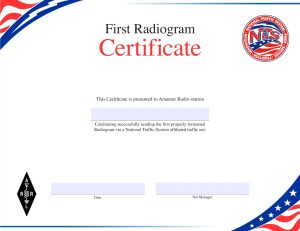As appeared in the June NTS Letter:
By, James Wades, WB8SIW
Emergency Management Director, Radio Relay International
Don Rolph, AB1PH, and his NTS Digital team have been experimenting with various digital methods to identify best practices for reliable transcontinental messaging within a time constraint of 30 minutes or less. There is precedent for these activities in the Cascadia Rising disaster exercise simulating a major earthquake and tsunami affecting the Pacific Northwest, which took place in 2016.
During Cascadia Rising, FEMA asked NTS and RRI volunteers to test connectivity between a simulated disaster area in the Pacific Northwest and the National Response Coordination Center (NRCC) in Washington, DC. The goal was to test the ability of these networks to provide timely and accurate emergency messaging under a wide range of propagation conditions using various radio-only modes and methods.
Before amateur radio resources could be tested, it was necessary to develop a cohesive plan for an efficient response to a regional or national disaster. While some broad guidelines had been promulgated in ARRL publications over the years, an actual disaster operations plan had never been developed. Therefore, a prototype “National Response Plan” was designed as a desideratum against which performance could be measured. This plan defined two operational frameworks for NTS assets, one being the familiar “routine” configuration of daily layered nets, and the other of which was a specialized “emergency” configuration designed to streamline the messaging process, while building in the network and administrative tools required to support critical served agency and NIMS functions.
Beginning in 2015, an engineering-grade exercise framework and evaluation process was designed, ensuring an objective and analytical analysis of network performance. Message traffic consisting of five-letter cipher group circuit test messages would be originated from Alaska, Idaho, Northern California, Oregon, and Washington state. This method could then be utilized to measure accuracy across tens of thousands of data points. Elapsed time from when a message was tendered for origination to when a message appeared in the data stream at the NRCC was also evaluated. A statistical process was then used to categorize problematic messages according to non-fatal and fatal errors. The exercise was also conducted in three phases to simulate variable high frequency propagation conditions (e.g. morning, afternoon, and night).
The objective evaluation results were quite positive, with some valuable insights gained:
- Despite making voice circuits available, RF propagation conditions were such that HF SSB proved insufficient for the task. In all cases, participants chose not to use this method.
- CW circuits performed very well, achieving an accuracy score of 99.998 percent against over 13,000 data points.
- The Digital Traffic Network achieved an equivalent accuracy score of 99.997 percent against slightly over 10,000 data points.
- The Alaska ARES intrastate digital network achieved an accuracy score of 100 percent. These messages were then transferred to a point-to-point CW circuit between Alaska and the Pacific Northwest for transcon relay to the NRCC.
- A superior message propagation time was achieved by the CW nets, with an average time elapsed of 11 minutes, providing better message propagation times than digital methods.
The prototype plan developed for Cascadia Rising has since evolved into the current Radio Relay International National Response Plan (NRP), which is now available in both English and Spanish. This plan has since been subjected to a variety of both internal and external exercises conducted with various agencies. In every case, the NRP has worked very well with minor adjustments being made after each exercise to always seek improvement. Ultimately, some useful conclusions from Cascadia Rising include:
- There is absolutely no substitute for traffic handling experience. Many of the key operators staffing the nets had years of traffic handling experience. Some also had extensive maritime or military experience. This lesson was repeated during Hurricane Maria a few years ago when the difference between experienced traffic handlers and spontaneous volunteers was extremely evident on nets.
- EmComm volunteers should not engage in “mode parochialism.” Some saw CW as obsolete, but despite having multiple methods available, CW came to the rescue, offering not just equivalent accuracy to digital methods, but better message propagation times between the simulated disaster area and the NRCC.
- When conducting an emergency exercise, the evaluation process must measure more than the ability to establish connectivity. It must measure the ability of the network and personnel to accurately and efficiently convey information, track messages, manage replies, interface with message routers, and maintain an organized file of messages originated or relayed, all while retaining a concise radio log.
If there is one “big” lesson from Cascadia Rising and subsequent disaster operations, it is the importance of being part of an organized system. The “prepper mentality” that one will turn on his radio and save the day may work in an isolated emergency, but when it comes to organized disaster response, it is merely a fantasy.
The ongoing efforts of Don Rolph and his NTS Digital team add another layer of capabilities that can enhance the diversity and reliability of a survivable network. There remains a place for skilled radio operators capable of improvising solutions and providing the professional grade of service to their community that makes a difference in time of emergency. The skills learned on NTS nets and the basic methods of managing record message traffic are the foundation of effective communications. This is why traffic nets are once again attracting those who seek a quality, professionally run organization.

